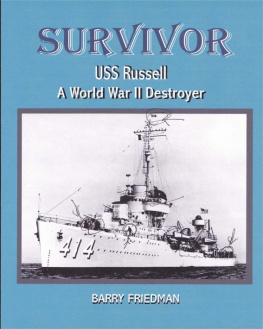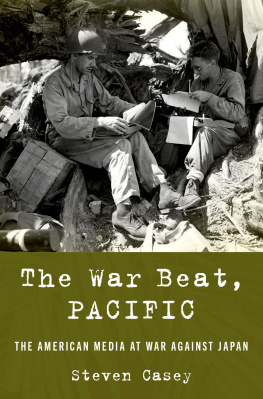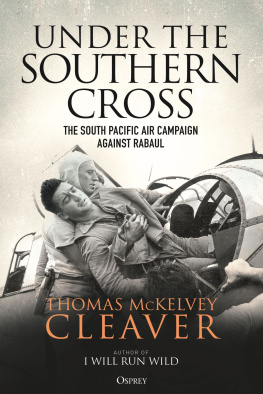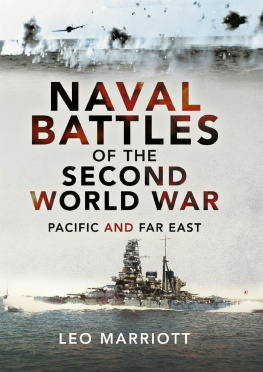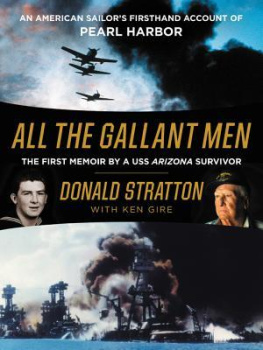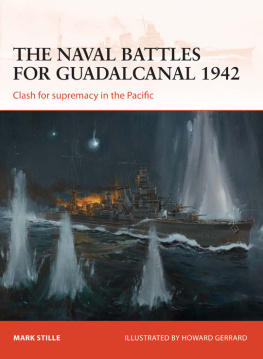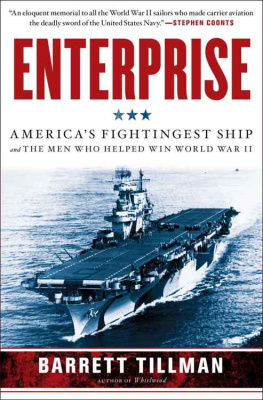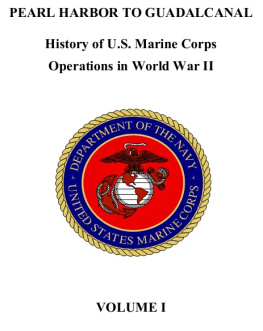SURVIVOR
USS Russell a World War Two Destroyer
By
Barry Friedman
Survivor: USS Russell a World War TwoDestroyer
by Barry Friedman
Copyright 2012 By Barry Friedman
All rights reserved
Smashwords Edition
ISBN: 9781476235073
Digital edition by: GoPublished
www.gopublished.com
Also by Barry Friedman
Novels
Dead End
Assignment: Bosnia
Prescription For Death
The Shroud
Sleeper
Hyde
Max
Thats Life: Its Sexually Transmitted andTerminal
The Old Folks at Home: Warehouse Them or Leave Them on the IceFloe
Fracture
Non-Fiction
The Short Life of a Valiant Ship
DEDICATION
To the men of the fighting Russell.They were the best of what Tom Brokaw had in mind when he termedthem The Greatest Generation.
And to the men and women of the newRussell (DDG-59) who are gallantly upholding the traditionof their namesake.
CONTENTS
Foreword
The history of USS Russell (DD-414)is a history of the pre-Pearl Harbor Battle of the Atlantic and ofthe Pacific War of 1941 to 1945.
In 1995, Robert Robbie Robinson,Russells Chief Quartermaster who became acommissioned officer, published a book titled The InvincibleRussell DD-414. Robbie devoted considerable time and effort toresearch the material for his book. Since it was privatelypublished with a limited circulation, I felt that the exploits ofRussell warranted a larger readership. Much of the presentbook was drawn from Robbies excellent narrative.
I was privileged to serve asRussells Medical Officer during part of her life,and have included my recollections, but the star of this chronicleis the ship.
Russells deck logs obtainedfrom the National Archives served as the bones of the story; themeat was supplied by personal recollections of her crew. To placethe ships exploits in the context of the time period during whichshe operated, I have included material obtained from a number ofinternet sources.
While this book is entirely factual, I havetaken an authors liberty of introducing some conversation whichconveys the thoughts if not the actual words of the speaker.
Chapter 1
On a chilly, drizzly day in late November,1938, Navy Lieutenant William Stamps Howard, Jr., hands stuffed inthe pockets of his Navy blue topcoat, stood in front of a dry dockat the Newport News Shipbuilding Co. in Newport News, Virginia. Lt.Howard gazed up in awe at the ship nearing completion, stillresting on a row of supporting planks and flanked on either side byscaffolds as high as the ship. From his vantage point, he could seeconstruction workers scurrying around the vessels deck. Welderstorches were spitting sparks. Colorful flags were strung from stemto stern, and red, white and blue bunting-covered prow, all inpreparation for the ships launching scheduled for the followingweek.
A small sign at the head of the dry dockread: DD414. DD was the Navys designation for a destroyer.
Lieut. Howard had attended enough Navyvessel christenings to know the drill: Mrs. Charles H. Marshall,the ships sponsor, standing on a platform at the ships bow, wouldutter the traditional words, In the name of the United States, Ichristen thee Russell. May you serve your country well. She would smash a bottle of champagne suspended by a wide ribbonacross the ships bow, to the applause and cheers of a bevy ofonlookers on the platform alongside her. TheRussells horn would emit an ear-splitting blast asshe slowly slipped stern first down the ways into the waters ofHampton Roads. Mrs. Marshall had named the ship to honor her lategrandfather, Rear Admiral John Henry Russell, a Civil WarNaval Officer.
Bill Howard, a 35-year-old, tall, slenderman, had graduated from the United States Naval Academy atAnnapolis in 1925. He had just arrived from Tuguila, Samoa where hehad been commanding officer of USS Ontario, a seagoing tug.Now, although he was going from commanding a ship to a post as thesecond in command, his new ship was a destroyer. He was slated tobe the Executive Officer of Russell.
Howard tingled with pride as he ogled hisship: sleek, thin-waisted and about as long as a football field. Ifshe had been submerged in seawater, the weight of the water shedisplaced would be 1500 tons. Her skin was light gray at birth,later painted a camouflage-colored razzle-dazzle.
The Russell was the fifth of whatwould eventually be twelve ships of the Sims Class, the lastdestroyers built with a single engine room and smoke stack. Allsubsequent destroyers had two engine rooms with stacks, so if oneengine was disabled, the ship would run on the second.
Another feature was a gun that automaticallycalculated range and elevation for the guns, taking into accountwind direction, air temperature, and ballistic factors for theguns. The director control tower for the main battery was placedhigh on the superstructure, for an unobstructed view. In battle,the system helped Russell gunners shoot down eight enemyplanes and sink a Japanese destroyer.
While Russell was under constructionin Newport News, a few miles away in Washington, D.C., Rear AdmiralAlexander H. Van Keuren, Chief of the Navys Bureau of Constructionand Repair received some disturbing news. The US Hammann,another Sims Class destroyer had made a tight figure-eightmaneuver at sea and, because of her top-heaviness rolled anestimated 56 degrees lasting four frightening minutes until theship managed to right itself. The incident could have beendisastrous.
Admiral Van Keuren held an emergency meetingwith his staff of Naval Architects and ordered an investigation andrecommendations. The group went over the blueprints of theHammann, did some calculations and came up with the cause ofthe violent roll: The ship, as did all of the Sims classdestroyers built to date was equipped with five 5 guns andturrets, and three quadruple torpedo mounts. The superstructure wasjust too heavy. Structural changes had to be made. Construction ofRussell was put on hold while the architects went back totheir drawing boards and slide rules. When they had finished, theirrecommendations were sent to the Russell shipbuilder.
To lower the ships center of gravity, thefifth 5 gun and its turret had to be removed as did the thirdquadruple torpedo tube. In addition, steel plates on the bridge hadto be replaced by aluminum. Finally, tons of lead sheets had tobe placed in the bilges under the boilers.
Walt Singleterry, who at the time was anelectricians mate aboard the Russell recalls I know it wasa hell of a lot of lead, I helped lug it.
When USS Russell was launched onDecember 8, 1938, almost three years to the day before the UnitedStates entered World War II., she would fight with four 5 guns.Also, on each side of the ships main deck were four.50 cal. guns,four 20mm guns, a rack of five depth charges and four 21torpedoes.
A year later, on 3 November, 1939,Russell was officially commissioned and ready for sea.
Lieutenant Commander J.C. Pollock, USN, herfirst skipper had under his command six officers, including Lt.Howard, thirteen chief petty officers and 138 other enlistedpersonnel, a total crew of 158 men.
Russell began her shakedown cruise inthe Caribbean on 12 December, 1939. During the entire month, theship and her crew were put through rigorous maneuvers and drillsdesigned to duplicate situations that might occur in heavy seas orbattle. Liberty port stops at Guantanamo Bay, Cuba and the VirginIslands provided short periods of rest and recreation for the hardworking crew, several of whom, misinterpreting the meaning ofrecreation, were overcome by the demon rum for which theCaribbean was noted, and were dragged back to the ship by the ShorePatrol. For these few, shakedown took on a new meaning. They wereawarded disciplinary action by Captain Pollock.

